No more naughty?

On Saturday, February 18, the Indian Space Research Organisation (ISRO) achieved yet another remarkable milestone with the successful launch of the GSLV-F14 rocket carrying the INSAT-3DS meteorological satellite from the Satish Dhawan Space Centre in Sriharikota. This achievement marks a significant advancement in India's space capabilities and underscores the nation's commitment to bolstering its meteorological monitoring and disaster management services.
The GSLV-F14 flawlessly deployed the INSAT-3DS satellite into its intended geosynchronous transfer orbit. This deployment signifies the beginning of a new era in Earth observation and weather forecasting. INSAT-3DS, a communication satellite developed by ISRO, represents the latest addition to the esteemed INSAT series of satellites. Designed to augment the capabilities of existing meteorological satellites, INSAT-3DS is equipped with payloads tailored for meteorological data collection, satellite-aided search and rescue operations, and the relay of crucial meteorological information. With its multifaceted functionalities, INSAT-3DS is poised to play a pivotal role in providing timely and accurate information for various sectors, including agriculture, disaster management, and aviation.
The successful launch of GSLV-F14 and the deployment of INSAT-3DS highlight ISRO's commitment to pushing the boundaries of space exploration and technology. Interestingly, more than the satellite INSAT 3DS, it is the launch vehicle, i.e., GSLV-F14 that has come into spotlight. Unlike the highly successful Polar Satellite Launch Vehicle (PSLV) and Launch Vehicle Mk III (LVM3), the GSLV series is notoriously known for its high failure rate. Of the 16 times it has flown, GSLV has failed 4 times. For the sake of comparison, PSLV has failed merely twice in its 60 operations, and LVM3 has never been unsuccessful in its 7 operations. There is no surprise then that GSLV has been dubbed as a “naughty boy” and scientists have conferred upon it the moniker like “sea-loving satellite”. The success of GSLV is very important because it is more powerful than the PSLV and has specialised utility. Following Saturday’s success, an attempt has been made to rebrand GSLV as a “disciplined boy.”
The relevance of ISRO’s latest success can be gauged from the fact that GSLV is all set to carry out its most prominent operation thus far in the not-so-distant future. It will carry the all-prestigious NISAR (NASA-ISRO Synthetic Aperture Radar) satellite in space. This mission, a collaborative effort between ISRO and NASA, represents a pinnacle of achievement for the GSLV programme and will undoubtedly put its capabilities to the ultimate test.
As we look ahead to the future, it's imperative to recognise the invaluable contributions of ISRO's scientists, engineers, and all those involved in making this launch a resounding success. Their dedication, ingenuity, and tireless efforts continue to take India's space programme to greater heights, inspiring generations and fostering innovation along the way. To sum up, Saturday's successful launch of GSLV-F14 carrying INSAT-3DS is not just a triumph for ISRO; it's a reflection of India's indomitable spirit of exploration, innovation, and progress. One must celebrate this achievement and look forward with optimism to the next chapter in India's remarkable journey through the cosmos.




